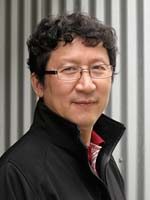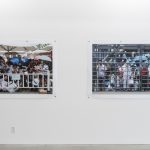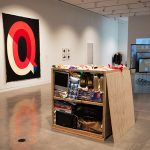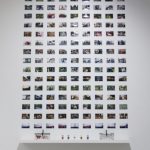Xiong Gu
Research Area
Education
MFA, BFA (Sichuan Fine Arts Institute)
About
Gu Xiong is a multimedia artist from China who now lives in Canada. He works with installation, painting, drawing, printmaking, sculpture, photography, video, digital imagery, text, and performance art. He has exhibited nationally and internationally, including more than sixty solo exhibitions and three public art commissions. He has participated in over one hundred prominent national and international group exhibitions, including the 17th Venice Architecture Biennale Parallel Exhibition (The Change of Enclosed House – A Dialogue About Chinese Immigrant Architecture, 2021); the Second Anren Biennale in Chengdu (A Confrontation of Ideals, 2019); Every. Now. Then: Reframing Nationhood at the Art Gallery of Ontario, 2017; Beyond Image at the Hubei Museum of Art, 2015; the 55th Venice Biennale Parallel Exhibition (Voice of the Unseen, Chinese Independent Art 1979 – Today, 2013); Border Zones: New Art Across Cultures at the UBC Museum of Anthropology in Vancouver, 2010; Post Avant-Garde Chinese Contemporary Art – Four Directions of the New Era in Hong Kong, 2007; the Shanghai Biennale, 2004; MultipleCity in Panama, 2003; Le Mois de la Photo in Montreal, 2001; the Montréal Biennale, 2000; the Gwangju Biennale, 1995; Here Not There at the Vancouver Art Gallery, 1995; and the ground-breaking exhibition China Avant-Garde at the China National Museum of Fine Arts in Beijing, 1989. His works are represented in the collections of the National Gallery of Canada, the China National Museum of Fine Arts, and the Vancouver Art Gallery, among many other museums and private collections.
Gu has done three large public art projects in Canada and the United States: the Washington State Major League Baseball Stadium in Seattle, the Seattle Public Library’s Columbia City Branch, and the Donald Forster Sculpture Park at the University of Guelph, Ontario.
In addition to publishing five books, sixteen solo exhibition catalogues, and eleven book covers, Gu’s artwork has been widely reproduced in journals and received significant critical recognition, including reviews in Flash Art, Art in America, and Canadian Art. The documentary The Yellow Pear: The Story of Gu Xiong from the series A Scattering of Seeds: The Creation of Canada was broadcast on the History Channel in March 2001.
Gu’s practice centres on the creation of a hybrid identity arising from the integration of different cultural origins. Through the critical angle of visual art, his work encompasses sociology, geography, economics, politics, and literature, as well as the dynamics of migration, invisible labor, globalization, local culture, and identity politics, through which he constitutes an amalgamation of multiple cultural histories and seeks to create an entirely new identity.
Gu received his BFA and MFA degrees from the Sichuan Fine Arts Institute in Chongqing, China. He twice attended the Banff Centre for the Arts as artist-in-residence, in addition to residencies hosted by various colleges and universities in Canada, the United States, and China. He has served on the Canada Council Visual Art Grant Jury, the Seattle Arts Commission Jury, the BC Arts Council Jury, and the Vancouver Foundation Jury. As Professor in the Department of Art History, Visual Art and Theory at the University of British Columbia, Gu Xiong is engaged in both studio art and contemporary art theory.
For more information and to view selected works, visit Gu Xiong’s personal website.
- Synchronize I, II, III. Gu Xiong
- A Migrant Worker’s Crate. Gu Xiong
- “Illuminated” Niagara Falls. Gu Xiong
- “Illuminated” Niagara Falls. Gu Xiong
Teaching
Research
Migration, identity, installation, painting, drawing, photography, print media, video, performance art
Publications
Gu Xiong has published two books, ten solo exhibitions catalogues and eleven book covers. His writing and art works are published in art catalogues, magazines, and newspapers. His artwork has received significant critical recognition including reviews in the New York Times and the international art magazines Flash Art and Art in America. The documentary The Yellow Pear: The Story of Gu Xiong from the series A Scattering of Seeds: The Creation of Canada was broadcast on the History Channel in March 2001. In the capacity of curator, Gu Xiong has organized critically acclaimed exhibitions of work by emerging artists in Canada and China.




A published Book by Gu Xiong (1997).
This book was published in 1997 by Arsenal Pulp Press/Burnaby Art Gallery.
Gu Xiong came to Canada from China to find freedom and a new life, but with it came the uneasy feeling of being a stranger in a strange land, with customs, attitudes, and ways of living far different from what he and his family had known in China. The Yellow Pear is a collection of deeply personal narratives (appearing in both English and Chinese) and illustrations about life in his adopted country, a life which resonates with the past he left behind. In these disarmingly simple words and images, which connect community to personal identity, Gu seeks to find his own place in the world. You may purchase a copy of this book online by clicking here. Also, for accessing a preview of this book click here.




Published book pictured by Gu Xiong and authored by Paul Yee. (1998)
This book was authored by Paul Yee and pictured by Gu Xiong. The Boy in the Attic is the story of Seven-year-old Kai-ming Wong and his family who have just moved from their village in China to a big city in North America. Everything is new and different and Kai-ming is lonely. The children he sees playing outside speak a language he cannot understand, and because it’s summertime, there is no school.
But one day Kai-ming meets a mysterious boy his age living in the attic of his house. Kai-ming and Benjamin play together all summer but Kai-ming tells no one about his new friend.
When Kai-ming’s father announces that the family can move to a nicer house because he has found a job, Kai-ming doesn’t want to leave. But when he learns the truth about Benjamin he realizes that to make a life for himself in this new country, he must learn the language and find new friends.
Children who must face a change in their lives by moving or immigrating will find much to identify with in this wonderful modern ghost story.
You may purchase this book from Amazon by clicking here.




A book by Thomas J. Berghuis, includes a section featuring Gu Xiong’s performance entitled Interior View – Fence Wall (2006).
Performance Art in China was published by Timezone 8, Beijing, China, 2006. Author of this book includes a section on page 87-88, featuring Gu Xiong’s theatrical performance staged in the China Art Gallery, Interior View.
The following paragraph is a brief description of this book published on its cover:
“Performance Art in China takes as its subject one of the most dynamic and controversial areas of experimental art practice in China. In his comprehensive study, Sydney-based theorist and art historian Thomas J. Berghuis introduces and investigates the idea of the “role of the mediated subject of the acting body in art,” a notion grounded in the realization that the body is always present in art practice, as well as its subsequent, secondary representations. Through a series of in-depth case studies, Berghuis reveals how, during the past 25 years, Chinese performance artists have “acted out” their art, often in opposition to the principles governing correct behavior in the public domain. In addition to a 25-year chronology of events, a systematic index of places, names and key terms, as well as a bibliography and a glossary in English and Chinese, this study also offers the reader numerous previously unpublished photos and documents.”




A book by Robert Kelly and Carl Leggo, featuring a sub-section about Gu Xiong published by Calgary: Detselig Enterprise Ltd (2008).
The second section of this book, titled Ruminations on Creative, includes a sub-section from page 67-75 featuring Gu Xiong called In My Own Words. The sub-section includes a short biography of Gu Xiong, an essay by him, and a selective collection of his art works and poems.
The following paragraphs is taken from Robert Kelly’s website. You may purchase this book from his website by visiting this page.
“Creative Expression, Creative Education is a book for educators and parents that presents the case for creativity as a primary rationale for education. It serves as an introduction to the contemporary vocabulary, theory and practice of creativity in education and implications for educational practice. Twenty Canadian creative producers from a variety of creative arts disciplines bearing witness to personal acts of creativity are featured in the main section of this volume.”




A book edited by Cheryl Mclean and Robert Kelly featuring a chapter about a group project involving Gu Xiong published by Calgary: Detselig Enterprise Ltd (2011).
This book includes a chapter on pages 213-236 featuring one of Gu Xiong’s group project, The City of Richgate. You may visit the exhibition page by clicking here.
The following paragraph is a description of this book:
Creative Arts in Research for Community and Cultural Change features illustrative articles describing the creative arts in research and practice within neighbourhoods, villages, and cities for community and cultural change. In these times of desperate need and ongoing unrest internationally, this research collection — featuring leaders across disciplines — is a valuable source of information as well as a call for creative new approaches in contemporary research leading to action and change. The articles in this book will be of special interest to university based educators; artists and researchers; facilitators; practitioners; educators in the social sciences; social work and social justice professionals; activists and community change agents; heritage, cultural, and urban planners; healthcare professionals and public health educators; fundraisers and many others. Creative Arts in Research for Community and Cultural Change is a research book that provides first hand insights into evolving and participatory processes unique to the CAIP, as well as a wealth of information and examples for relevant in-depth dialogue and debate.




College textbook by Lu Hong featuring some of Gu Xiong’s art work (2014).
The author mentions Gu Xiong on pages (130-131).
The text below is short description of the book.
“Mr. Lu Hong’s “History of Chinese contemporary art from 1978 to 2008” is a concept from the history of the style are spectacular. Several years ago, he has produced a “cross-border: Chinese avant-garde art from 1978 to 2004”, the title is displayed a distinct value orientation. The book is written on the front of the base, just as its purpose OF preface said: “just want to Ventura matched to the majority of students and readers vivid and clear review of this new artistic tradition from the birth to the continuous development growth process. “REVIEW Review of the object clearly established and thus put the common period” avant-garde “to be let go, so the book will show that the cutting-edge content. For example, the 1980s and 1990s, many artists including several old masters are still alive, he is from the “Cultural Revolution” robbing more than the ruins of a new start. If art history is an exhaustive, it should be an equivalent space to review some “old new flowers.” But this book, in addition to Wu courage to change the ink more, because of the need to discuss the concept of consistency or occasionally mention foreign “bird pier” (huang), “Beauty line” (Cheng Shifa) and other works, this has substantially deep skill-old group declined to comment. Similarly, for many was when young, and now getting better, but there is no sense of avant-garde painters, this book were never ignored.”




A book Edited by Richard King published by UBC Press, includes a chapter dedicated to Gu Xiong (2010).
This book has a dedicated chapter about Gu Xiong published on pages (107-118). The following sentences are taken from the introduction section of this book (page 10).
“Many of the finest artists of the post-Mao age had spent some of their formative years as rusticated urban youths. These include the multimedia artist Gu Xiong, now based in Vancouver, whose reflections on his “rustication” experience appear in Chapter 4 of this volume.” This chapter’s title is When We Were Young: Up to the Mountains, Down to the Villages.
You may purchase the book from UBC Press by clicking here. The paragraph below is the description of the book.
“Forty years after China’s tumultuous Cultural Revolution, this book revisits the visual and performing arts of the period – the paintings, propaganda posters, political cartoons, sculpture, folk arts, private sketchbooks, opera, and ballet – and examines what these vibrant, militant, often gaudy images meant to artists, their patrons, and their audiences at the time, and what they mean now, both in their original forms and as revolutionary icons reworked for a new market-oriented age. Chapters by scholars of Chinese history and art and by artists whose careers were shaped by the Cultural Revolution offer new insights into works that have transcended their times.”




A journal magazine published by Canadian Society for Education through Art (CSEA), featuring Gu Xiong’s art work on the front and the back cover (2009).
The Canadian Art Teacher is a journal magazine published by Canadian Society for Education through Art (CSEA) two times a year. Gu Xiong was the featured artist of Volume7. Number 2 of this journal. His Art work was the front and the back cover of this Journal.
The journal also includes an extra double sided poster that focuses on some of Gu Xiong’s famous art works.




A book written by Marie Claire Huot, published by Duke
University Press, featuring Gu Xiong’s art work on the front cover (2000).
The book’s front cover features an image taken from Gu Xiong’s installation, Here, There, Everywhere.
The book may be purchased from the publisher’s website. The following is a brief description of the book taken from the publisher’s website.
“The Cultural Revolution of China’s Maoist era has come and gone, yet another cultural revolution of a different sort has been sweeping through China in the 1990s. Although recently much interest has been focused on China’s economy, few Westerners are aware of the remarkable transformations occurring in the culture of ordinary people’s daily lives. In China’s New Cultural Scene Claire Huot surveys the wide spectrum of art produced by Chinese musicians, painters, writers, performers, and filmmakers today, portraying an ongoing cultural revolution that has significantly altered life in the People’s Republic.
With a comprehensive index of artists and works, as well as a glossary of Chinese words, China’s New Cultural Scene will enlighten students of Chinese culture and general readers interested in contemporary Asia.”




Elementary school textbook published by Toronto: Nelson Education Ltd featuring a section about Gu Xiong (2008).
Gu Xiong’s poem and artwork is taught in a grade 7 text book (Nelson Literacy 7c) in the province of Ontario, Canada.
This text book covers a short biography of Gu. It also includes one of his poems, Home, and a few of his other artworks. This section is published on pages 114-116.
Nelson Literacy is a text book taught in the province of Ontario, Canada. You may visit their website by clicking here.




A quarterly magazine, featured Gu Xiong’s work on the cover page and covered a collection of his work (1995).
Gu Xiong’s work was the front cover of the Vol. 34, No. 1 Fall 1995. This edition’ Creative Non-Fiction/Art was also dedicated to Gu Xiong, featuring some of his drawings and writings on pages 44-53.
Please click here to visit the magazine’s website. The following paragraph about Prism International.
“PRISM international is a quarterly magazine out of Vancouver, British Columbia, whose mandate is to publish the best in contemporary writing and translation from Canada and around the world. Writing from PRISM has been featured in Best American Stories, Best American Essays and The Journey Prize Stories, amongst other noted publications.”




Magazine of Art & Everyday Life featuring a performance by Gu Xiong and Henry Tsang (1992).
Harbour published, Shock Culture: A Performance, by Gu Xiong and Henry Tsang in Vol 1, No. 4 1992 on pages 46-48.
Voices Rising
Asian Canadian Cultural Activism, a book by Xiaoping Li that includes a chapter about Gu Xiong as one of the “Voices” (2007).
Gu Xiong is featured as one of the voices in this book published by UBC Press. There is a dedicated chapter about Gu Xiong in section 2 of this book, Voices, under Cross the Threshold on pages 195-203.
The following paragraph is a short description of the book taken from the publisher’s website. You may purchase this book from the publisher by clicking here.
“Voices Rising examines Asian Canadian political and cultural activism in the late twentieth century around such issues as community building, identity making, racial equity, and social justice. Informed by a postcolonial cultural critique, Xiaoping Li draws on historical sources and compelling personal testimonies to show how culture acts as a means of engagement with the political and social world.”
Arts and Learning Research Journal
A journal published by the American Educational Research Association features Gu Xiong’s installation on the front and back cover (2009).
Arts and Learning research journal Vol 25, No. 1 features Gu Xiong’s installation, You & I, on the front cover. This edition also includes a brief one page biography of Gu Xiong as the cover artist.
The Arts and Learning Research Journal is published yearly and distributed in April by the Arts and Learning Special Interest Group of the American Educational Research Association.
TCR: The Capilano Review
A journal published by The Capilano Press Society, features Gu Xiong’s photograph on the front and back cover (2012).
The Capilano Review journal, Vol 3, No. 16, 2012 features Gu Xiong’s photograph, The Concrete Nail, on the front and back cover. It also includes a section about Gu Xiong’s group research project in collaboration with Jennifer Chung, and Chris Lee, Waterscapes: Working Notes on Globalization, on pages 36-48.
The print edition of TCR is published three times a year. A pdf version is available for purchase simultaneously. Our website features a free e-magazine called ti-TCR | a web folio, also published three times a year.
Pacific Canada: beyond the 49th parallel
UCLA Asian American Studies Center Press, featured Gu Xiong’s photograph on the back cover and included a section about his work (2007).
Amerasia journal, Pacific Canada: beyond the 49th parallel, Vol 33, No. 2, 2007, featured Gu Xiong’s photograph from his I Am Who I am exhibition. This edition also includes a section featuring Gu Xiong’s group exhibition, Richgate, on pages 115-124.
Amerasia Journal is an interdisciplinary academic journal covering Asian American studies. It was established in 1971 by editor-in-chief Lowell Chun-Hoon, publisher Don Nakanishi, and members of the Yale University Asian American Students Association.
The Semblance of Identity
Aesthetic Mediation in Asian American Literature by Christopher Lee featuring Gu Xiong’s edited photograph from his installation on the front cover (2012).
The front cover of this book features a photograph from Gu Xiong’s installation, You and I, which was edited by Rob Ehle, the designer of the book cover.
The Semblance of Identity was published by Stanford University Press and authored by Christopher Lee. You may purchase this book from Amazon. The following paragraph is a brief description of the book.
“The history of Asian American literature reveals the ongoing attempt to work through the fraught relationship between identity politics and literary representation. This relationship is especially evident in literary works which claim that their content represents the socio-historical world. The Semblance of Identityargues that the reframing of the field as a critical, rather than identity-based, project nonetheless continues to rely on the logics of identity.”
EVENT
A literary magazine is published by, and affiliated with, Douglas College, featured Gu Xiong’s photograph on the front cover of an edition (2004).
Event magazine, Vol 32, No. 3, 2004, published Gu Xiong’s photograph, Forbidden City Kodak, on the front cover. It also includes the following quote from Gu Xiong:
“A seamless merging of designs, almost invisible at first glance. A subtle adaptation to the ‘no signage’ dictate of the Forbidden City, this doorway provides a power vision of post colonialism.”
EVENT is published by, and affiliated with, Douglas College, a non-profit public institution of higher education based in New Westminster, B.C., Canada.













